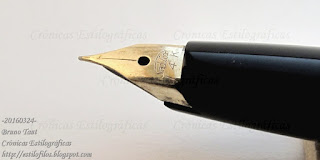There is more to retractable-nib pens that just the
Pilot line of Capless pen
currently on production. Stipula, Lamy, Visconti, Stypen… even Montblanc has something like a retractable-nib pen… And there are some lesser known companies re-interpreting this style of pen.
One of them is the Chinese company Wuhan Pen Factory, located in Wuhan (Hubei province, PR China). Under its brand name Dagong, it produced the model 56 during the 1980s.
 The box of the Dagong 56. Knock-type (push button) fountain pen, by Wuhan Pen Factory.
The box of the Dagong 56. Knock-type (push button) fountain pen, by Wuhan Pen Factory.
The Dagong 56 is made of stainless steel and has a gripping section in black knurled plastic. The nib –of gold plated steel— is operated by a push button at the back of the pen. The filling mechanism is an aerometric system integrated in the nib unit.
 The empty box and the nib unit. The nib is made of stainless steel, gold plated. The filling system is a built in aerometric.
The empty box and the nib unit. The nib is made of stainless steel, gold plated. The filling system is a built in aerometric.
The pen clearly follows the Capless tradition of Pilot, but it is not easy to pinpoint which particular Pilot model was the source of inspiration. In fact, it looks like if the designers of the Dagong 56 had taken elements from several of the Pilot pens. The result, however, is attractive while keeping it clean and simple.
 The Dagong 56, on the front, together with the Pilot Capless from 1971 on. The latest of those shown on the pic, close to the Dagong, started its production in 1998 and, therefore, it could not be a model in any way for the Chinese pen.
The Dagong 56, on the front, together with the Pilot Capless from 1971 on. The latest of those shown on the pic, close to the Dagong, started its production in 1998 and, therefore, it could not be a model in any way for the Chinese pen.
The click mechanism looks and sounds sturdy—maybe too much so, as it requires some strength to operate it. Apparently reliable, but less refined than the mechanism of the Pilot pens. Both, Pilot and Dagong, share an important element—a closing lid to prevent the nib going dry. This is not so obvious as there are other Chinese-made capless pens that do not implement such a lid.
The construction quality is decent, but shows some flaws. The steel, particularly on the nose has some obvious imperfections: it has some pores, and its surface is far from uniform. The mouth for the nib is not well finished—the lower edge is not straight and could erode the feed.
 This picture shows some of the flaws of the Dagong 56. The steel has some obvious imperfections, and the opening for the nib is not nicely cut. Inside, by the way, there is a white lid to prevent the nib from drying out when the pen is not in use.
This picture shows some of the flaws of the Dagong 56. The steel has some obvious imperfections, and the opening for the nib is not nicely cut. Inside, by the way, there is a white lid to prevent the nib from drying out when the pen is not in use.
 The engraving on the nib is very shallow and is barely visible. It includes the logo and the name of the manufacturing company: "WUHAN".
The engraving on the nib is very shallow and is barely visible. It includes the logo and the name of the manufacturing company: "WUHAN".
These are the dimensions of the pen:
Length closed: 139 mm
Length open: 144 mm
Diameter: 11 mm
Weight: 16.5 g (dry)
Ink deposit: 0.7 ml
 A nice detail: the threads are made of steel on both sides.
A nice detail: the threads are made of steel on both sides.
Now, is this pen competitive? The Dagong 56 is no longer on production and it is mostly a rarity for collectors. The price at auction sites, erratic as it may be, often reaches EUR 60 to 70. Given the current exchange rates, a
stainless steel Pilot Capless seems a much better deal.
Chuanren 3323, Student Pen – Wagner 2008 ink (by Sailor)
Bruno Taut
Shinjuku, Nakano; February 6th, 2016
etiquetas: Wuhan, Capless, Pilot

















































